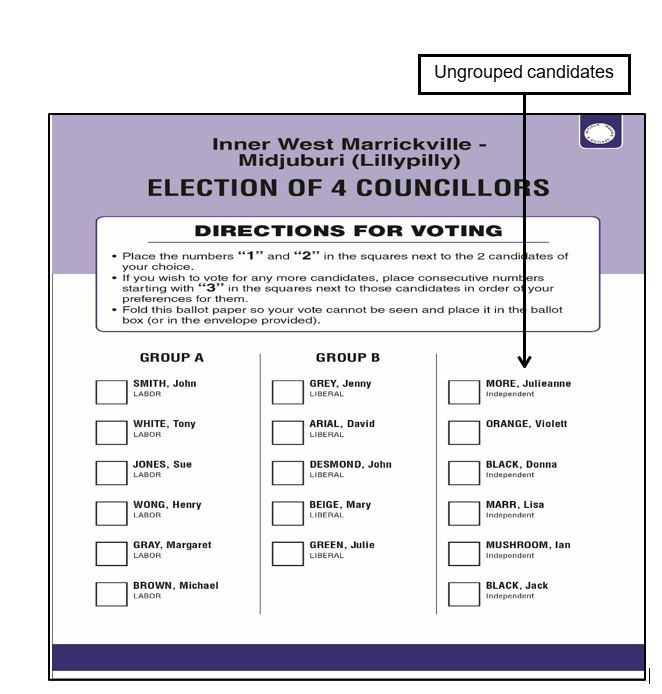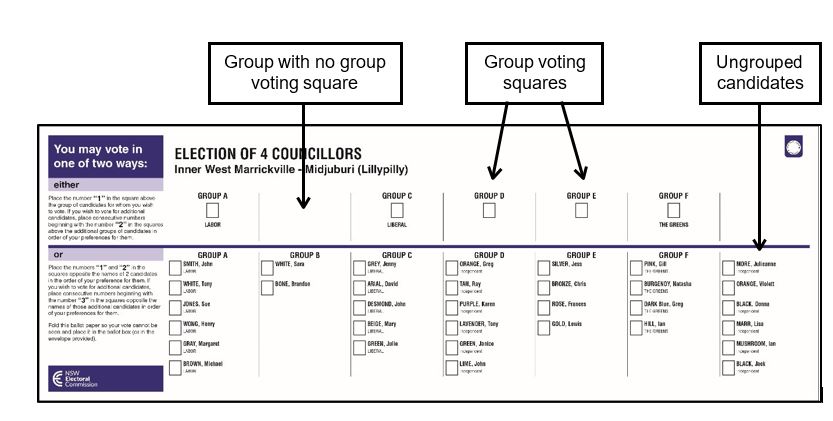How to cast your vote in a local government election
On this page
The number and type of ballot papers in a local government election will vary from council to council. In addition to a councillor ballot paper, an elector may receive a mayor ballot paper (if the mayor is popularly elected), a referendum ballot paper and/or a poll ballot paper if the council has resolved to conduct a referendum or a poll.
Referendum and polls ballot papers will vary based on their content, but mayor and councillor ballot papers will have either an ungrouped or grouped structure, as follows.
Election | Ballot paper type |
|---|---|
Mayor | No groups |
One councillor to be elected | No groups |
Two or more councillors to be elected | No groups; or |
Referendum / Poll | Contains one or more questions |
Two or more councillor candidates can form a group on a ballot paper. A ballot paper can have one or more groups. Groups may represent registered political parties or groups of independent candidates who have formed to run collectively. Groups may have a group voting square printed above the line on the ballot paper, allowing voters to vote above the line for the entire group.
Ballot papers
Before the election, the returning officer for each council conducts a ballot paper draw, pulling the candidate names out of a ballot box at random.
The names of the candidates are listed vertically according to the ballot paper draw order. If the candidate is endorsed by a registered political party, the name of that party is also shown. If the candidate is not endorsed by a registered political party, they can choose to have 'Independent', or nothing, printed next to their name on the ballot paper.
Example of a councillor ballot paper with no groups

Example of a councillor ballot paper with groups but no voting squares

How to vote
To vote, you must place at least the number of preferences indicated in the ‘Directions for Voting’ on the ballot paper. This will be at least half the number of candidates to be elected (rounded up).
For example:
if there is one candidate to be elected, you must vote for at least one candidate
if there are three candidates to be elected, you must vote for at least two candidates
if there are four candidates to be elected, you must vote for at least two candidates
if there are nine candidates to be elected, you must vote for at least five candidates
You may then continue to number more candidates if you wish.
Your first preference is indicated by placing a ‘1’ in the square next to the candidate of your choice, your second preference a ‘2’, your third preference a ‘3’, and so on.
Ballot paper with group voting squares
Before the election, the returning officer for each council conducts a ballot paper draw to determine the order in which groups are listed on the ballot paper, and then the order in which ungrouped candidates are listed on the ballot paper.
The groups and ungrouped candidates are listed according to the ballot paper draw order. If the candidate is endorsed by a registered political party, the name of that party is also shown. If the candidate is not endorsed by a registered political party, the group is identified by a letter of the alphabet.
Grouped candidates
A ballot paper with group voting squares has a thick line running across it, with group voting squares above the line and columns of candidate voting squares below it. Below the line, the group candidates are listed in columns directly beneath their group voting square. The group chooses the order they list their candidates below the line.
The squares above the line allow voters to vote for all candidates listed in that group (with the topmost candidate receiving the highest preference in that group, and the bottommost candidate receiving the lowest preference in that group).
Ungrouped candidates
Candidates not included in a group are shown in a column on the right-hand side of the ballot paper, in ballot paper draw order, and these are referred to as ungrouped candidates.
Example paper
The following diagram shows how a Councillor ballot paper with group voting squares is structured. Candidates are divided into groups and labelled alphabetically e.g. Group A, Group B, Group C, etc.

How to vote
When completing your ballot paper, you must choose between voting above the line or below the line.
Above the line
You must place a number ‘1’ in one of the group voting squares above the thick horizontal line on the ballot paper. By doing this you are voting for that whole group of candidates in the order they are listed below that square, starting from the top. This is all you need to do.
You can show more choices if you want, starting with the number 2 above the line.
If you vote above the line, do not put numbers in any squares below the line.
Below the line
You can vote below the line if:
you want to vote for candidates within a group in the order of your choice
you want to vote for candidates from different groups in the order of your choice
- you want to vote for ungrouped candidates in the order of your choice
you want to vote for a mixture of grouped and ungrouped candidates.
To vote, you must place at least the number of preferences indicated in the ‘Directions for Voting’ on the ballot paper. This will be at least half the number to be elected (rounded up).
For example:
if there are three to be elected, you must vote for at least two candidates
if there are nine to be elected, you must vote for at least five candidates
You may then continue to number more candidates if you wish.
Your first preference is indicated by placing a ‘1’ in the square next to the candidate of your choice, your second preference a ‘2’, your third preference a ‘3’, and so on.
If you vote below the line, do not put numbers in any squares above the line.
